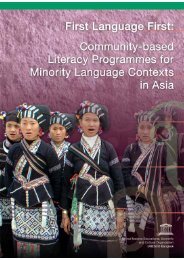Part II.pdf - MTB-MLE Network
Part II.pdf - MTB-MLE Network
Part II.pdf - MTB-MLE Network
You also want an ePaper? Increase the reach of your titles
YUMPU automatically turns print PDFs into web optimized ePapers that Google loves.
a significant number of minority groups live in different parts of the country. They have separate<br />
social, cultural, religious and economic identities, and are easily distinguishable by their different<br />
religious, language, and cultural characteristics. Inter-community administrative and judicial systems,<br />
patterns of marriage, social and family life, and values that they continue to preserve and practise<br />
also contribute to this separate identity. (S. Akhter & M. Kamal)<br />
2. Social Context of Tribal People<br />
The ethnic communities live mostly in the border regions of the country with a numerically larger<br />
Bengali population. Distinctly different from the majority of the country, ethnic communities are<br />
sometimes forced into situations that generate tension and conflict at the cultural, psychological<br />
and economic levels.<br />
Broadly speaking, there are three linguistic families among the tribes in Bangladesh. These are:<br />
• Tibeto-Burmese: All the tribes of Chittagong Hill Tracts (CHT) and the Garos, Kochs,<br />
and Tipras<br />
• Austro-Asiatic or Mon-Khmer: Khasis, Santal, Mundas, and Mahalis<br />
• Dravidians: Oraons, Paharis, etc.<br />
The Chakma and Tanchingya language is a dialect variant of Bengali. The Rajbanshis, Pahari,<br />
Kochs and Pathors have lost their original language, and have been speaking Bengali. Almost all<br />
the tribal people are now bilingual. They have learnt the Bengali language in order to communicate<br />
with wider Bengali society; however, they speak their own language among themselves. The Garos<br />
and Khasis are matrilineal, while other tribes are patrilineal. Though a moiety structure is found<br />
among the Garos, all other tribes have a clan system.<br />
The majority of indigenous peoples in the Barind and north central region are the original inhabitants<br />
of the Chotonagpur Plateau (Ali. A: Santals of Bangladesh, 1996).<br />
The table below shows the linguistic breakdown of the tribal communities in northwestern Bangladesh<br />
that have been working under the ASHRAI literacy project:<br />
Name of the Ethnic Community Language they speak Other Language<br />
1. Santal Santali Can understand<br />
Bangla<br />
2. Oraons<br />
• in Barind Tract Sadri Do<br />
• in Dinajpur Area Kuruk Do<br />
3. Pahans Sadri Mixed Do<br />
4. Mundas Santali Mixed Do<br />
5. Mahatos Sadri<br />
6. Raj Khatriyos or Sing Khatriyos Sadri Mixed Do<br />
7. Rajowars Sadri Mixed Do<br />
8. Mahalis Santali Mixed Do<br />
9. Karmokar Sadri & Hindu Mixed Do<br />
139
















